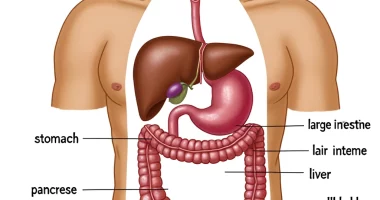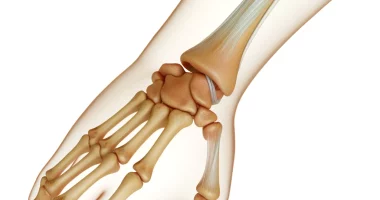Autoimmune hepatitis
Definition
Autoimmune hepatitis is a progressive chronic inflammation of the liver with signs of periportal or more extensive involvement and the presence of autoantibodies in liver cells. Clinical manifestations include vegetative disorders, jaundice, right subcostal pain, skin rashes, hepatomegaly and splenomegaly, amenorrhea in women, and gynecomastia in men. Diagnosis is based on serologic detection of antinuclear antibodies (ANA), tissue antibodies to smooth muscle (SMA), antibodies to liver and kidney microsomes etc., hypergammaglobulinemia, increased IgG titer, and liver biopsy data. Treatment is based on immunosuppressive therapy with corticosteroids.
General information
In the structure of chronic hepatitis in modern gastroenterology, autoimmune liver disease accounts for 10-20% of cases in adults and 2% in children. Women get autoimmune hepatitis eight times more often than men. The first age peak of incidence occurs before age 30, and the second occurs in postmenopause. The course of autoimmune hepatitis is rapidly progressive, in which liver cirrhosis, portal hypertension, and liver failure develop relatively early, leading to the death of patients.
Causes
The etiology of autoimmune hepatitis is poorly understood. It is believed that the development of autoimmune hepatitis is based on linkage to certain antigens of the major histocompatibility complex (HLA) – DR3 or DR4 alleles, detected in 80-85% of patients. Epstein-Barr, hepatitis viruses (A, B, C), measles, herpes viruses (HSV-1 and HHV-6), and certain medications (e.g., interferon) may be presumed triggers of autoimmune reactions in genetically predisposed individuals. More than a third of patients with autoimmune hepatitis have other autoimmune syndromes, such as thyroiditis, Graves’ disease, synovitis, ulcerative colitis, Sjogren’s disease, and others.
Pathogenesis
The basis of the pathogenesis of autoimmune hepatitis is the deficiency of immunoregulation: a decrease in the subpopulation of T-suppressor lymphocytes, which leads to the uncontrolled synthesis of IgG by B-cells, destruction of the membranes of liver cells—hepatocytes—and the appearance of characteristic serum antibodies (ANA, SMA, anti-LKM-l).
Classification
Depending on the antibodies formed, autoimmune hepatitis I (anti-ANA, anti-SMA positive), II (anti-LKM-l positive), and III (anti-SLA positive) types are distinguished. Each type is characterized by a distinctive serological profile, course, response to immunosuppressive therapy, and prognosis.
- Type I. It occurs with the formation and circulation in the blood of antinuclear antibodies (ANA) – in 70-80% of patients; antiglandular muscle antibodies (SMA) in 50-70% of patients; antibodies to the cytoplasm of neutrophils (pANCA). Autoimmune hepatitis type I develops more frequently between the ages of 10 and 20 years and after the age of 50 years. It is characterized by a good response to immunosuppressive therapy and the possibility of achieving persistent remission in 20% of cases, even after withdrawal of corticosteroids. In the absence of treatment within three years, liver cirrhosis forms.
- Type II. Antibodies to liver and kidney microsomes type 1 (anti-LKM-l) are present in the blood of 100% of patients. This form of the disease develops in 10-15% of cases of autoimmune hepatitis, mainly in childhood, and is characterized by high biochemical activity. Autoimmune hepatitis type II is more resistant to immunosuppression. When drugs are withdrawn, relapse occurs frequently, and liver cirrhosis develops twice as often as in autoimmune hepatitis type I.
- Type III. Antibodies to soluble hepatic and hepatic-pancreatic antigens (anti-SLA and anti-LP) are formed. ASMA, rheumatoid factor, antimitochondrial antibodies (AMA), and antibodies to hepatic membrane antigens (anti-LMA) are quite often detected in this type.
Variants of atypical autoimmune hepatitis include cross-syndromes that also include features of primary biliary cirrhosis, primary sclerosing cholangitis, and chronic viral hepatitis.
Symptoms of autoimmune hepatitis
In most cases, the pathology manifests suddenly, and in clinical manifestations, it does not differ from acute hepatitis. At first, it proceeds with marked weakness, lack of appetite, intense jaundice, and the appearance of dark urine. Less often, the onset of the disease is gradual; in this case, vegetative disorders, malaise, heaviness, pain in the right subcostal region, and slight jaundice predominate. In some patients, autoimmune hepatitis begins with fever and extrahepatic manifestations.
The period of advanced symptoms of autoimmune hepatitis includes marked weakness, a feeling of heaviness and pain in the right subcostal area, nausea, skin itching, and lymphadenopathy. Autoimmune hepatitis is characterized by intermittent, increasing periods of exacerbation of jaundice and enlargement of the liver (hepatomegaly) and spleen (splenomegaly). A third of women with autoimmune hepatitis develop amenorrhea and hirsutism; boys may have gynecomastia. Typical skin reactions: capillaritis, palmar and lupus-like erythema, purpura, acne, and telangiectasias on the skin of the face, neck, and hands. In periods of exacerbations of autoimmune hepatitis may be observed phenomena of transient ascites.
Systemic manifestations of autoimmune hepatitis include recurrent migratory polyarthritis affecting large joints but not leading to their deformation. Quite often, autoimmune hepatitis occurs in combination with ulcerative colitis, myocarditis, pleurisy, pericarditis, glomerulonephritis, thyroiditis, vitiligo, insulin-dependent diabetes mellitus, iridocyclitis, Sjogren’ssyndrome, Cushing’s syndrome, fibrosing alveolitis, hemolytic anemia.
Diagnosis
Autoimmune hepatitis is diagnosed during a consultation with a hepatologist or gastroenterologist. Criteria for pathology are serologic, biochemical, and histologic markers. According to international criteria, autoimmune hepatitis can be talked about if:
- there is no history of hemotransfusions, hepatotoxic drugs, or alcohol abuse;
- markers of active viral infection (hepatitis A, B, C, etc.) are not detected in the blood;
- γ-globulin and IgG levels exceed average values by 1.5 or more times;
- AsT, AlT activity is significantly elevated;
- antibody titers (SMA, ANA, and LKM-1) for adults above 1:80 and for children above 1:20.
Liver biopsy with morphologic examination of the tissue sample reveals a picture of chronic hepatitis with signs of marked activity. Histologic signs of autoimmune hepatitis are bridge or step necrosis of parenchyma and lymphoid infiltration with an abundance of plasma cells. Instrumental studies (liver ultrasound, liver MRI, etc.) in autoimmune hepatitis have no independent diagnostic value.
Treatment of autoimmune hepatitis
Pathogenetic therapy of the disease consists of immunosuppressive therapy with corticosteroids. This approach reduces the activity of pathological processes in the liver, increases T-suppressors’ activity, and reduces the intensity of autoimmune reactions that destroy hepatocytes.
Usually, immunosuppressive therapy in autoimmune hepatitis is carried out with prednisolone or methylprednisolone in the initial daily dose of 60 mg (1st week), 40 mg (2nd week), 30 mg (3-4 weeks) with a reduction to 20 mg as a maintenance dose. The reduction of daily dosage is done slowly, taking into account the activity of the clinical course and the level of serum markers. The patient should take the maintenance dose until the clinical, laboratory, and histological parameters are completely normalized and normalized. Treatment of autoimmune hepatitis can last from 6 months to 2 years and sometimes throughout life.
If monotherapy is ineffective, it is possible to introduce azathioprine, chloroquine, and cyclosporine into the treatment regimen of autoimmune hepatitis. In the case of the ineffectiveness of immunosuppressive treatment of autoimmune hepatitis for four years, multiple relapses, and side effects of therapy, the question of liver transplantation is raised.
All these treatment options are available in more than 150 hospitals worldwide (https://doctor.global/results/diseases/autoimmune-hepatitis). For example, liver transplantation can be done in 24 clinics across Germany (https://doctor.global/results/europe/germany/all-cities/all-specializations/procedures/liver-transplantation).
Prognosis and prevention
If autoimmune hepatitis is untreated, the disease progresses steadily; spontaneous remissions do not occur. The outcome of autoimmune hepatitis is liver cirrhosis and liver failure; 5-year survival rate does not exceed 50%. With timely and well-tolerated therapy, remission can be achieved in most patients, with a 20-year survival rate of more than 80%. Liver transplantation yields results comparable to drug-induced remission, with a 5-year prognosis favorable in 90% of patients.
Only secondary prevention is possible in autoimmune hepatitis, including regular monitoring by a gastroenterologist (hepatologist), liver enzyme activity, γ-globulin content, and autoantibodies for timely strengthening or resumption of therapy. Patients with autoimmune hepatitis are recommended a gentle regime with limited emotional and physical stress, diet, withdrawal from prophylactic vaccination, and medication restriction.

